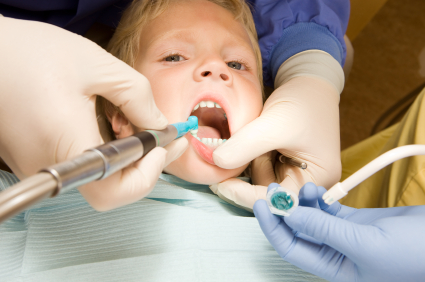Dental Care of Children and Teens – causes and prevention of caries (cavities)
Recently there has been developed a new technique of dental care which, if proves successful, may totally change dental practice.
Several different contributing factors to cavities have been known for some time; but, protecting against them is a different matter.
A new technique called "dental sealing" seems to have finally been perfected and may form an important part of total dental care.
Most cavities occur where dental hygiene is difficult, that is: the surfaces of teeth facing each other; the pits and fissures of biting surfaces; and at the gum line.
Dental caries (cavities) are actually a bacterial infection of the tooth.
Three things, plaque, sugar, and a tooth susceptible to acid, are all necessary for this infection to occur.
Within twenty minutes after sugar containing food is eaten, the sugar mixes with dental plaque converting to an acid and begins attacking the tooth enamel.
Decay occurs gradually after several repeated attacks.
Theoretically all that one needs to do to prevent caries is to get rid of these three components.
First, avoiding frequent use of sugar containing foods is a good plan! Every grandmother, "old-wive" a (and dentist) can tell you that children who eat a lot of sweets get more cavities.
But elimination is not totally possible as almost every food contains a certain amount of sugar.
Second, removing dental plaque is not all that difficult either. But it takes learning how to brush your teeth in a certain way: and, unless parents or dentists teach this method, the children will not learn it.
All tooth surfaces must be brushed, including the molars (back teeth), the back side of the teeth, and the teeth at the gum lines.
Even with meticulous brushing, however, the surface between the teeth is impossible to clean except by using dental floss.
 When I recently asked children in my office if they were flossing their teeth, I was somewhat surprised to find that almost none of them were (less than 5%).
When I recently asked children in my office if they were flossing their teeth, I was somewhat surprised to find that almost none of them were (less than 5%).
I can tell you from experience it also pays to have the dentist or dental hygienist specially clean the teeth with their instruments, every six to twelve months.
Cleaning a baby’s teeth should begin as soon as the first tooth erupts. A damp cloth should be rubbed across the child’s teeth and gums after every feeding. A soft toothbrush and toothpaste can also be used.
A sight which seems, to me at least, to becoming more common is that of a toddler with silver front teeth.
These are silver caps placed by a dentist to treat what is known as "nursing bottle caries."
These occur in children who have "sweetened" binkies, bottles for sleep and bottles for longer than a year of age.
Third, we now have two things which increase the tooth’s resistance to acid/bacterial decay: fluoride and the sealing mentioned above.
Fluoride is well known for it’s ability to strengthen teeth. But there is a very wide variation in the amount of natural fluoride in the water of a community and so parents should supplement the child’s or teen’s diet.
When there is less than 0.3 parts per million in the drinking water the following schedule of fluoride supplementation should be used: 1 month to 2 years old, 0.25 milligrams fluoride daily; 2-3 years old, 0.50 milligrams fluoride daily; 3 years and older, 1 milligram fluoride daily.
Infants who receive only breast milk should be given 0.25 milligrams daily regardless of the fluoride concentration in the drinking water.
The "swish and rinse" program in the schools are, in my opinion, inadequate and do not replace the need for daily fluoride tables or fluoride toothpaste.
In fact if you are following these procedures, "swish and rinse" programs should not be used.
Fluoride, while helpful in preventing cavities on smooth surfaced, does little to prevent decay in irregular tooth surfaces; this is where dental sealing comes in.
A 2 year study showed more than a 65% reduction in cavities when dental sealing technique was used together with periodic fluoride treatment.
This sealant is a hard resin material which is bonded to the biting and chewing surfaces of the teeth. First, a mild acid solution is applied to the teeth to clean them and then this special plastic sealing material is painted over the tooth surfaces.
One such treatment may protect against decay for an entire lifetime, however, in approximately 15% of cases the bond doesn’t last and must be repeated.
A child’s first visit to the dentist should occur between 1 – 3 years of age depending upon the preference of your dentist.
The first visit, ideally, is to meet the dentist, see the office, ride up and down in the chair, receive a quick oral inspection and dental hygiene instructions.
Parents who plan for good dental health with nutritious prenatal and infant diets, appropriate use of fluoride, proper dental hygiene, no bed time bottles, and possibly dental sealing, will in most likelihood spend very little on major dental care.

